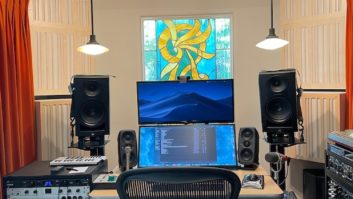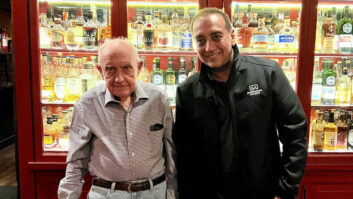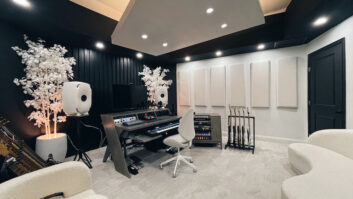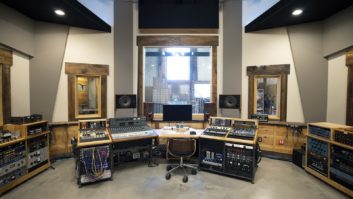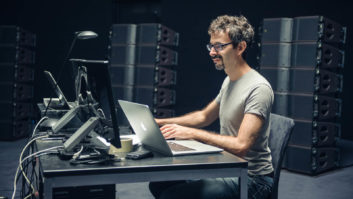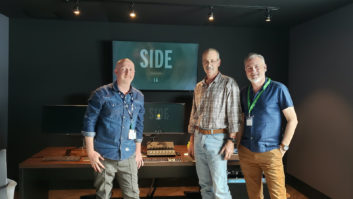In the studio design and acoustics business, from the smallest project room to the largest multi-room complex, every element interacts; change one design component, and it will have an impact on the final result. As a result, as the audio industry has evolved, especially in terms of the production process and currently available technology, studio design and acoustics have also evolved.
As Russ Berger, president, Russ Berger Design Group (RBDG), observes, “It’s all being driven by the equipment.” The digital revolution in the audio industry has certainly taken the business into a new phase and away, to a certain extent, from large for-hire facilities to personal, often home-based, studios. “It put these tools into the hands of a lot of other people who realized they were able to be creative and get involved,” he says. “But when a home studio is striving for the same kind of production as a commercial facility, they also need to step up their game with respect to the acoustics of the recording spaces and monitoring environments.”
Central to that similarity has been a general move away from using large-format mixing consoles in favor of digital audio workstations. That’s obviously had an impact on acoustical design, as Hanson Hsu, principal, Delta H Design, explains.
“You have someone with a monitor, a mouse and a keyboard; you don’t have a large console any more. But people buy 4-foot by 8-foot custom wood tables to put everything on, so they end up with a massive reflective surface anyway,” he says.
Typically, such a setup also includes an outboard rack and a patchbay, Hsu continues. “The problem acoustically is that the outboard rack is usually never more than two racks wide, so they don’t put it behind them but to the left or the right. That throws off the low end and gives you a reflection on only one side. And because there’s less outboard gear, they don’t always fill the rack. Then, the high frequency’s not coming off the front of the rack but going in the rack and bouncing around.”
“The furniture is definitely important,” agrees Berger, noting, “Some manufacturers are better than others in minimizing their acoustical footprint and not creating undesirable reflection paths.”
But regardless of the equipment, there are certain constants that affect any design, one of which is fundamental, according to Berger: “It’s always about people.” He elaborates, “People have to access the technology, they have to communicate, they have to be able to hear accurately and reliably in multiple formats, and they need to have a reference for the group so they can work collaboratively. And there’s always a visual aspect, even if it’s just a waveform running in front of you.”
Hsu agrees: “We do still see a lot of glass. Our clients really need the human connection when they’re tracking.”
For those on a more modest budget, there are manufacturers such as Auralex Acoustics who are able to consult on treatment options and deliver a solution from a catalog of products relatively quickly. According to Auralex general manager Jeff Lantz, just over half of the company’s customers work in project studios, and two-thirds of those own their spaces. Vocal booths, rehearsal spaces and live rooms are the next most common projects.
Pictured are Collective Soul’s drummer, Cheney Brannon
(left) and front man Ed Roland in Roland’s Auralex-treated
studio space in Atlanta. The company website includes an online form for prospective clients to complete that allows Lantz and the staff to understand the core issues of any project, and tailor the solution accordingly: “If we’re talking about someone who is doing voiceover work, then bass traps might not be the best thing for them to start with. But if we’re talking to someone in a control room who is doing a lot of mixing, then they may have some bass issues that they want to correct.”

“Typically, we’re looking at the ability to at least design the entire treatment; it doesn’t mean they purchase the entire treatment plan,” says Lantz, noting that the typical Auralex customer spends between $500 and $2,000. “One of the things that we do is break it out into phases, so if they can’t do the whole thing, this is what we recommend first.”
Treatments such as those sold by Auralex offer one advantage over a total room construction, of course— they can be affixed temporarily and removed later. For some of Hsu’s music producer clients that are converting a room in their house, “One question is always how much it will cost to remove the studio, and how long will it take, when they sell the house. You might have to knock a quarter or half million off the price of the house [when it’s sold], because they don’t know what to do with a trapezoidal room with a window in it.” Delta H Design’s registered ZR Acoustics, which treats a room without resorting to a traditional trapezoidal wall layout, avoids some of that problem, he says.
Both Berger and Hsu have seen a general trend away from soffitmounted audio monitors. “Not having soffit-mounted speakers saves tens of thousands of dollars on the construction of the front end of the room,” observes Berger. “That’s a pretty complex piece of work. But by moving the speakers from the soffits into the room, we’ve complicated the way the low frequency behaves in the room with respect to the left, center, right and surrounds. This creates some new challenges: Speakers need to be placed appropriately, so subwoofers and bass management become your friends.”
Berger has an answer to the need for visual monitoring: “We use a lot of projection. It’s the only way that you can get an image the size of the audio. When you’re trying to make judgments about how loud the vocal track should be; is something stepping on something else; how wide, how deep it should be—all those things require you to have emotional impact from this video image and respond to it with your audio product.” A micro-weave or micro-perforated projection screen also allows proper placement of the center channel speaker, he points out.
The Russ Berger-designed Sweetwater Studio at the
company’s headquarters in Fort Wayne, IN is
LEED-certified and illustrates the industry’s general
trend of moving away from soffit-based monitors to
stand-mounted monitors. Increasingly, clients have a desire to be “green,” according to Lantz, and Auralex has responded with various products. “Our StudioFoam has a soy component, so it’s eco-friendly, although it certainly has some nonrenewable components. We have SonoFiber, which is a recycled cotton material, and we’ve got EcoTech, made of recycled products.”

Late last year Auralex introduced its Sustain Bamboo Sound Diffusors line. “With the WaveLens and Wave- Prism we were able to offer at a lower price than the non-renewable products [that they replaced]. To throw a non-sustainable product out and then to be able to offer it at a lower price we thought was a real win for our consumers.”
Berger, who has completed six LEED (Leadership in Energy and Environmental Design)-certified facilities, with a half-dozen more on the drawing board, comments, “It doesn’t cost anything to be more mindful about sustainable materials. It takes a little more time to research, and to make sure that you’re using them properly acoustically requires you to be creative.”
But, he adds, “Sustainable design shouldn’t even be a question anymore, it should be a given; it’s just the right thing to do.”


